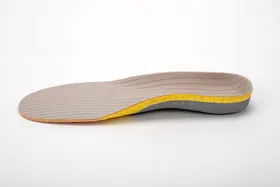Pros & Cons of HyProCure—Can You Fix Your Foot Deformity?
Updated February 1, 2024

Flat feet are generally asymptomatic. However, it sometimes results in painful conditions in the foot, ankle, leg, and knee. When this happens, curing the pain from flat feet becomes the goal.
In treating the conditions associated with flat feet, there are many treatment methods. They include NSAIDs, ice, physiotherapy, orthotics, and surgery. While there are several surgical approaches, more people are opting for HyProCure by the day.
HyProCure is a minimally invasive surgery to correct any misalignment between the heel and ankle bones and improve arch height. The innovative process repositions the ankle bone on the heel. Subsequently, a titanium stent is attached to stabilize the motion of the ankle bone over the heel, thus improving ankle motion.
» Looking to avoid surgery? Take a look at the best insoles for flat feet to help with malalignment
How Does HyProCure Work?
HyProCure works by restoring the stability of the ankle bone and its alignment with the heel bone. Instead of using an insole for flat feet, a titanium stent is inserted into the ankle area to control abnormal foot motion and stabilize the ankle.
The stents come in different sizes, and the most appropriate size for the individual is selected during the procedure based on the arch profile and degree of control needed.
Once implanted, the stent remains permanently in position without becoming less effective. It may become necessary to remove the implant only if there is a problem with the soft tissues absorbing the stent.
Benefits of HyProCure
Among the treatments for flat feet, the HyProCure procedure poses significant benefits. Some of the most important are discussed below:
Gait Correction
Overpronated feet and overpronated ankles commonly occur with flat feet. When the heel and ankle bones are aligned through HyProCure, the overpronation associated with flat feet is corrected. Consequently, the body weight rolls naturally forwards during walking.
Alleviates Pain
With overpronation, there is additional strain on the structures of the feet, causing pain and discomfort. The more the overpronation, the more the pain. HyProCure reduces the pressure on the plantar fascia, heel, and posterior tibialis tendon. It redistributes the pressure on the feet, alleviating pain and discomfort in the kinematic chain.
Simple Procedure
HyProCure is minimally invasive and can be performed quickly with the patient experiencing very little pain during the process. Post-operative healing is also generally quick.
Provides a Permanent but Reversible Solution
HyProCure provides a permanent solution to the problem of flat feet, removing the need for orthotics. However, if needed, it is also reversible.
Disadvantages of HyProCure
Despite its benefits, there are also several disadvantages associated with using HyProCure because of its invasive nature (even though minimal) and the effect on the body. The most common ones are outlined below:
Infection
Most surgeries come with the real risk of infection to the surgical site. Sometimes, a deep infection can occur with HyProCure, warranting an incision, drainage, and implant removal.
Prolonged Pain
Though minimal, the HyProCure procedure is not without pain. There may be pain and tenderness for the first few months after the surgical procedure. In some cases, the pain may even extend for up to six months and beyond.
Wrong Size of Implants
HyProCure stents come in specific sizes. As such, the surgeon may trial size the stent to know which will fit appropriately. As a result, there may be overcorrection or under-correction warranting another additional surgical procedure after swelling and inflammation have subsided. For whatever reason the under-correction or overcorrection occurs, this is more pain, waste of resources, and time on the patient’s part.
Sprained Ankle Syndrome
Initially, the stent may place some stretch on the ankle ligaments temporarily, causing pain and discomfort when walking. In most cases, the ligament should adjust to the stress with supportive shoes, NSAIDs, bracing, and taping. However, if there is no improvement within six to eight months, it may become essential to remove the HyProCure.
Displacement of Implant
Sometimes, the stent may become displaced post-operatively. Usually, this occurs within the first four weeks after the surgical procedure. The displacement can become problematic if it is significant and may require a second surgical procedure to reposition it. Whatever the cause, the displaced implant can make HyProCure a source of significant pain and discomfort.
Should You Use HyProCure?
While HyProCure can fix your foot deformity, it also has its disadvantages. You should consult a medical professional before deciding on a course of action.








